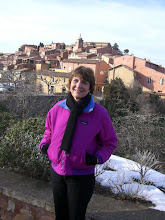Since we still had the car last Monday, we decided to go see another of the big towns of the Vaucluse: Orange. The area has undergone tremendous transformations and hardships over the centuries. Originally settled by the Gauls, it became a Roman colony around the year 35 BCE. The city went on to be attacked and partially destroyed by the Visigoths in the fifth century. Its population was decimated by la peste (“the plague”) in 1348 and again in 1720. In the sixteenth century the locale was settled by the Dutch whose ruling family is still named “the Royal House of Orange.” But today this city of about 30,000 people, known as having one of the warmest climates in France, is relatively quiet, yet proud of its heritage.
During Pax Romana, the time of peace and prosperity with the Gauls, the Romans created many buildings in the colony that they referred to as Arausio. There is an Arc de Triomphe on the outskirts of town, which is presently undergoing restoration. However, the crowning achievement of Roman architecture in the city is the antique theater. For a small fee, visitors can take a self-guided tour with audiophones of this 1st century structure built during the reign of Augustus. The theater has one of the best conserved murs de scène (“stage walls”) in the world; according to our audioguide only in Syria and Turkey could you also find such an impressive relic from Roman times. The sight of it in the seventeenth century prompted King Louis XIV to exclaim: « C’est la plus belle muraille de mon royaume. » ("It's the most beautiful wall in my kingdom.")

No comments:
Post a Comment